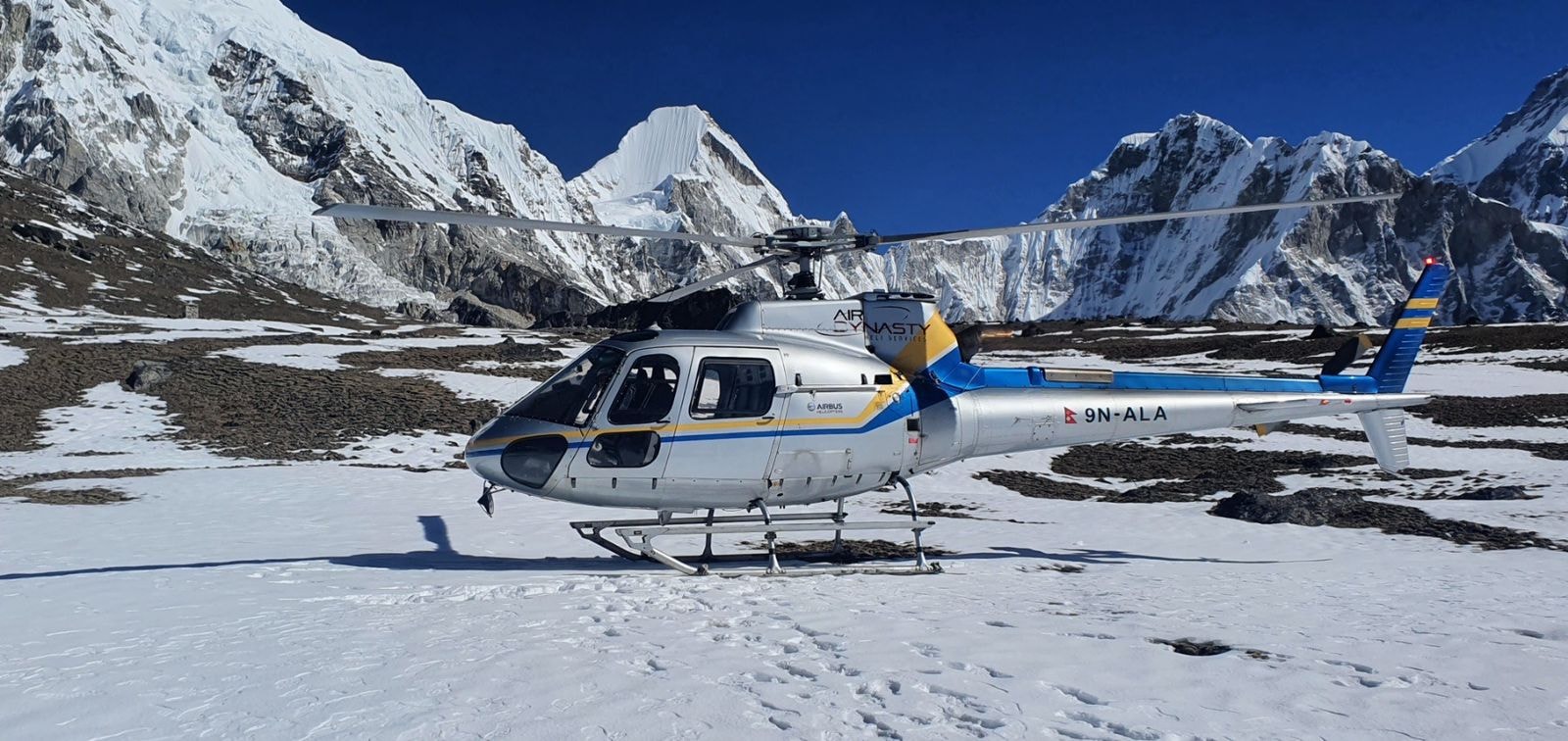After days of hiking through Nepal’s Khumbu Valley—pushing past exhaustion, conquering high-altitude passes, and finally standing in the shadow of Everest—it’s natural to ask yourself: “Do I really want to walk all the way back?”
For many trekkers, the descent from Everest Base Camp is just as physically demanding as the ascent. Sore legs, tight schedules and unpredictable weather can quickly turn the return trip into a slog. That’s where the Everest Base Camp trek with helicopter return is the game-changer.
This smart alternative blends adventure with efficiency: trek your way up, soak in every Sherpa village and mountain vista, then board a scenic helicopter ride back—cutting days off your itinerary while enjoying jaw-dropping aerial views of the Himalayas.
In this guide, we’ll break down exactly how this option works, what it costs, when to book it and whether it’s the right choice for your Everest adventure. If you’re short on time or simply want to skip the long descent without missing the full trekking experience, this might be the perfect balance of thrill and comfort. Let’s get into it.
Why Choose a Helicopter Return from Everest Base Camp?
The Strain of the Return Trek – Is It Worth It?
After reaching Everest Base Camp, many trekkers feel completely spent. The return trek to Lukla, while scenic, can feel repetitive and physically taxing. You’ve already climbed high passes, adjusted to altitude, and dealt with basic conditions. Going back down takes 3–4 days and it’s often downhill on sore legs and tired feet. The question becomes: Is it worth retracing the same trail?
Benefits of the Helicopter Return
Taking a helicopter return from Everest Base Camp skips the strain and adds a thrill. Instead of walking for days, you soar above the Himalayas in just 15–20 minutes. It saves time, energy and adds a scenic reward. You also get peace of mind knowing you can exit quickly if needed—especially useful if altitude sickness kicks in or your schedule changes.
Who Is This Option Best Suited For?
A helicopter return is perfect for trekkers short on time, tired or wanting a bit of comfort. It’s also great for older hikers or families with mixed fitness levels. You still get the full trekking experience going up—but finish with a breathtaking flight over Everest and its neighbors.
How Does the Everest Base Camp Trek with Helicopter Return Work?
Standard Trek Route Overview (Lukla to EBC)
The classic trek starts with a flight from Kathmandu to Lukla. From there you hike through Phakding, Namche Bazaar, Tengboche, Dingboche, Lobuche, and finally reach Gorak Shep and Everest Base Camp. The trek up takes 8–10 days including acclimatization stops.
When and Where Does the Helicopter Pick You Up?
Most helicopters pick up from Gorak Shep or Lobuche. Some also pick up from Kala Patthar, known for its stunning views of Everest. The pickup is scheduled in advance but can be flexible based on weather and trekker readiness.
Flight Duration and Landing Point (Lukla vs Kathmandu)
The helicopter ride from Gorak Shep/Lobuche to Lukla takes about 15 minutes. From Gorak Shep to Kathmandu it’s around 45–60 minutes. Many trekkers choose to fly directly to Kathmandu to skip the Lukla–Kathmandu flight which is often delayed due to weather.
Cost Breakdown: How Much Does an Everest Helicopter Return Trek Cost?
Average Trek Package Price with Helicopter Return
A typical Everest Base Camp trek costs around $1200–$1800. When you add a helicopter return expect the total package to range from $2000 to $3000. The exact price depends on whether you choose a group-sharing flight or a private charter.
What’s Included and What’s Not?
Packages usually include permits, domestic flights, accommodation, meals during the trek, guide and porter fees and the helicopter ride. Some may cover airport transfers and hotel nights in Kathmandu. Not included: travel insurance, tips, personal gear or extra days beyond the itinerary.
Factors Affecting the Cost
Several factors affect the cost: group vs private flight, time of year, group size and operator reputation. Helicopter availability also matters—prices go up during peak trekking seasons. Booking early helps to get better rates and flexibility.
When Is the Best Time to Do the Everest Base Camp Trek with Helicopter Return?
Seasonal Overview (Spring and Autumn)
Spring (March to May) and autumn (September to November) are the best time to combine the Everest Base Camp trek with helicopter return. These months offer good weather, clear visibility and dry trails. Rhododendron blooms in spring and crisp skies in fall.
During these periods you’ll have clear views of Everest and surrounding peaks and comfortable daytime temperatures. These seasons also coincide with the safest flying windows for helicopters making your return smoother.
Helicopter Flight Reliability by Season
Helicopter flights are highly weather dependent. In monsoon (June to August) heavy clouds and rain make flying risky and often lead to cancellations. Winter (December to February) can also be tricky due to snow, wind and low visibility at high altitudes.
Spring and autumn are popular for a reason—they offer the best chance for a reliable helicopter flight from Gorak Shep or Kala Patthar. Even so, always allow buffer time in your itinerary in case flights are delayed due to sudden weather changes.
Plan your trek around these seasons and you’ll get the most out of your experience—on foot and in the air.
Is the Everest Helicopter Return Safe and Reliable?
Operator Licensing and Pilot Expertise
Nepal’s top aviation companies use well-maintained helicopters and highly trained pilots experienced in high-altitude rescue and trekking routes. Always book with a licensed operator who follows Civil Aviation Authority guidelines. This ensures safety, accountability and up-to-date knowledge of flying conditions.
Altitude Risks and Emergency Evacuation Readiness
High-altitude trekking comes with risks like AMS (Acute Mountain Sickness). If symptoms worsen near EBC, helicopters provide a quick escape to lower altitude. Operators are trained in emergency evacuations and most helicopters are equipped with oxygen support.
Even if you’re not in distress, having this option adds a layer of confidence to your adventure. Weather can cause delays but with proper planning and communication the return flight is both safe and efficient.
Also Read: Top Treks In Nepal: Annapurna Circuit, Langtang Valley, Manaslu Circuit & Luxury Everest Base Camp
What to Expect on the Helicopter from Everest Base Camp
Scenic Points of the Flight
The helicopter ride is more than just transport—it’s the trip highlight. You’ll fly over glaciers, valleys and ridges with views of Everest, Lhotse, Ama Dablam and the Khumbu Icefall. Snow, rock and blue sky is a sight to behold.
The flight gives you a new perspective on the terrain you’ve just walked. A chance to relax, reflect and take in the Himalayas from a peaceful spot.
Tips for the Flight
Choose a window seat if possible. Morning flights are best for clear skies. Keep your camera handy but also take time to look and enjoy.
Wear warm layers—temperatures can drop quickly at high altitude. The helicopter ride is 15–20 minutes to Lukla and 45–60 minutes to Kathmandu. It’s quick, smooth and packed with scenery you’ll never forget.
How to Book Everest Base Camp Trek with Helicopter Return
Package or Custom Itinerary – Which One?
You can book a Everest Base Camp trek with helicopter return as a package or custom. Packages are convenient and include all permits, domestic flights, guides, accommodation, meals and the helicopter ride from Gorak Shep or Kala Patthar.
Custom itineraries let you adjust acclimatization days, side trips (Gokyo Lakes), or add luxury options (better teahouses or hotels in Kathmandu). If you have special requests or limited time, customization is worth the extra planning.
Questions to Ask Your Operator
Before booking, ask about the group size for the trek and the helicopter flight. Clarify pickup points, maximum altitude and if the helicopter lands in Lukla or Kathmandu. Is the helicopter private or shared and how flexible is the schedule in case of bad weather?
Also ask about refund policies, oxygen support on board and if insurance is required or included.
Can You Upgrade to Helicopter Return Mid-Trek?
Yes, many trekkers upgrade mid-way. This is common among those who are tired or short on time. Most agencies can arrange helicopters from Everest Base Camp even if it wasn’t planned at the start—just expect higher cost for last minute booking and limited availability during peak season.
Conclusion: Is EBC Trek with Helicopter Return Worth It?
If you’re wondering whether it’s worth combining Everest Base Camp trek with helicopter return, the answer is: yes—for many. It’s a smart way to balance physical challenge with comfort and convenience. You still get to experience the thrill of reaching base camp but avoid the long and repetitive descent.
Helicopter return saves up to 4 days, making the trip doable in a shorter window. It’s also ideal if your body is worn out, you’re worried about altitude, or you just want to end your adventure on a high note—literally.
The aerial views are stunning, the flight is efficient and it adds a new dimension to your Everest journey. It’s not just about skipping a hike—it’s about enhancing your overall experience.
While it comes with extra cost, the time saved, physical relief and the views make it worth the investment for most.
Whether you’re trekking solo, with a group or as part of a luxury trip, a helicopter from EBC is an upgrade many can’t resist.



